More crosses of religious communities
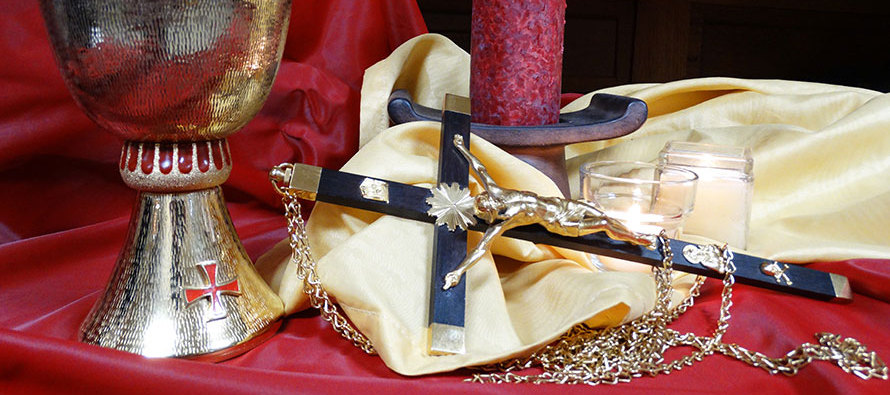
Missionaries of the Precious Blood
Dayton, Ohio
The founder of the Missionaries of the Precious Blood, Saint Gaspar del Bufalo, wore a crucifix close to his heart to focus himself and others on his mission to renew the church through the Precious Blood of Jesus. The mission cross is presented to each member at his definitive incorporation into the community of priests and brothers. With its gold chain, it is often worn on a cassock. The cross includes two small gold symbols below Jesus on the cross. The first is an image of the Sorrowful Mother, taking her place at the feet of her crucified son. Below that is a skull and crossbones, meant to symbolize that we are all mortal and that our eternal fate rests in the hands of Jesus, who conquered death for us.
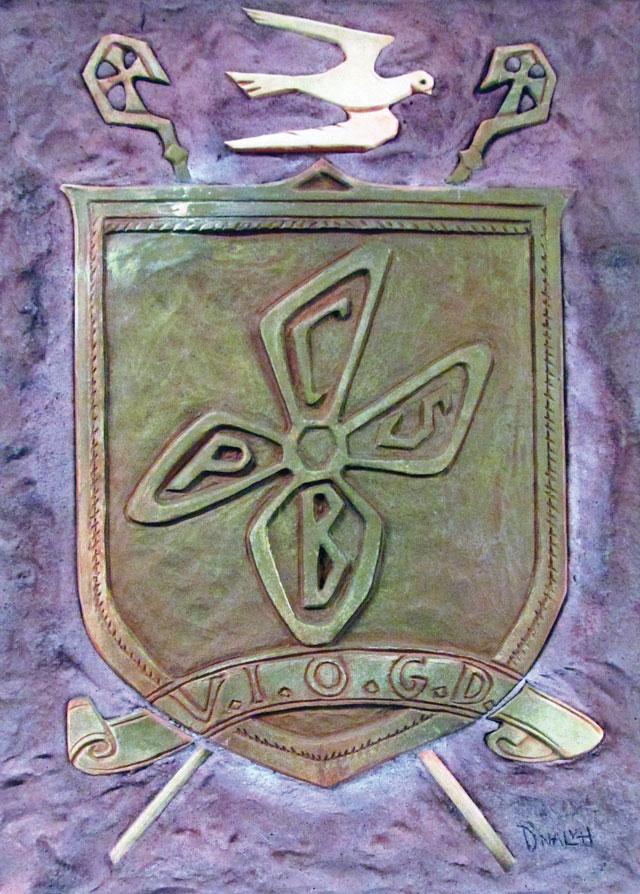
Monaster
Benedictine Sisters of St. Scholastica Monastery
Fort Smith, Arkansas
In Benedictine communities, work is a form of prayer. One of the Sisters of St. Scholastica Monastery in Fort Smith, Arkansas, community artist Sister Roberta Hyland, works in a variety of media—oils, watercolor, serigraph, bas relief, and tile—wearing an apron over her traditional habit. Her form of prayer reflects her faith and the Benedictine charism, reminding sisters and guests that when they work with reverence they, too, create something beautiful for God. Among her works is the community’s cross and coat of arms in bas relief in clay, which hangs in front of the monastery office.
After Vatican II, when St. Scholastica Monastery gave its members the option of remaining in traditional garb or wearing contemporary dress and an external symbol identifying them as community members, Sister Hyland was asked to design a unique Benedictine cross. Created in 1967, it bears the letters C.S.P.B. (“Crux Sancti Patris Benedicti,” or “cross of the Holy Father Benedict”). In 1987, Sister Roberta made the community logo the centerpiece of a coat of arms. Her design depicts a shield and a streamer with the letters U.I.O.G.D. (“Ut in Omnibus Glorificetur Deus,” or “that in all things God may be glorified,” a phrase taken from the Rule of Benedict). A dove, symbolic of the soul of St. Scholastica ascending into heaven, flies above the shield. Two staffs, representing the crosiers of Saints Benedict and Scholastica, flank the dove.
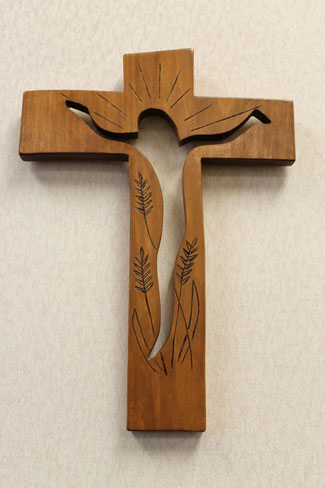
Franciscan Sisters of Perpetual Adoration
La Crosse, Wisconsin
The Franciscan Sisters of Perpetual Adoration are committed to being loving presence through prayer, witness, and service. They commit themselves to building Christ's kingdom of justice and peace through efforts to preserve and nurture God's creation, increase social and global consciousness, educate themselves to political awareness, and encourage action to effect change.
The Adoration Chapel at St. Rose Convent, the motherhouse in La Crosse, Wisconsin, serves as a location for perpetual adoration of the Blessed Sacrament. Franciscan Sister of Perpetual Adoration Rita Mae Fisher adorned this cross with wheat, symbolizing the Eucharist so central to the charism of their community.
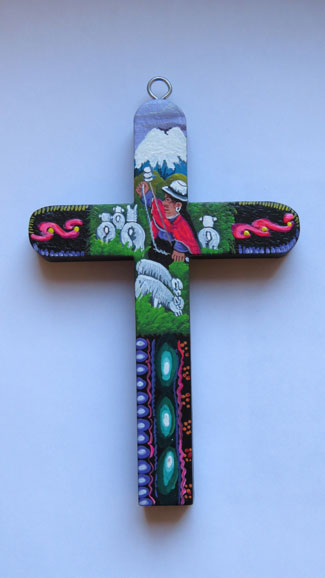
Sisters of the Good Shepherd
St. Louis, Missouri
Zeal for the salvation of souls—the activity of love in service—animates the lives of the Sisters of the Good Shepherd. Zeal is a fourth religious vow that Sisters of the Good Shepherd take, in addition to taking vows of poverty, chastity, and obedience.
A Sister of the Good Shepherd can express her zeal for God’s people either as an apostolic or contemplative sister. The apostolic community serves others through social justice and human service ministries across the United States. The contemplative community supports the Good Shepherd apostolic ministries through prayer and a dedication to the Eucharist by making and distributing altar bread. While the two lifestyles are vastly different, Sisters of the Good Shepherd share a common vision of saving souls through compassion, mercy, and reconciliation.
For the Sisters of the Good Shepherd, an artist in Ecuador painted a cross depicting sheep and a shepherd, symbolic of Jesus as the Good Shepherd, to convey the charism of the community.
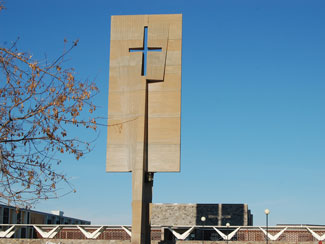
Benedictine Sisters of Annunciation Monastery
Bismarck, North Dakota
The Bell Banner at the Benedictine Sisters of Annunciation Monastery in Bismarck, North Dakota, was designed by world-renowned architect Marcel Breuer to stand sturdy in the prairie soil, representing the stability, strength, and deep roots of the community. The open cross at the top was designed to represent the risen Christ and let the North Dakota winds sail through. Once a year, on December 21, a shadow of the cross is cast on Our Lady of the Annunciation Chapel. The sisters always hope for sun that day!
The sisters live as a monastic community according to the Rule of Benedict. The women strive with others to respond to the challenges of the times and to further the mission of Jesus by prayer, lectio, and service.
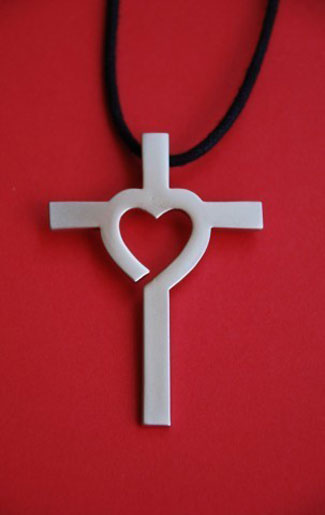
Brothers of the Sacred Heart
Baton Rouge, Louisiana
Community is at the heart of life for the Brothers of the Sacred Heart. They live together as a family trying to follow the example of Jesus. By sharing, friendship, teamwork, and prayer together, they learn to understand the joy and promise of a life of service.
Their cross depicts the pierced heart of Jesus on the cross. It symbolizes the spirituality of love that characterizes the Brothers of the Sacred Heart and their willingness to imitate Jesus' compassionate love, to go as far as to suffer with, on behalf of, and because of children and young people, especially those who are poor and without hope. Young people are the focus of their apostolic and missionary activity.
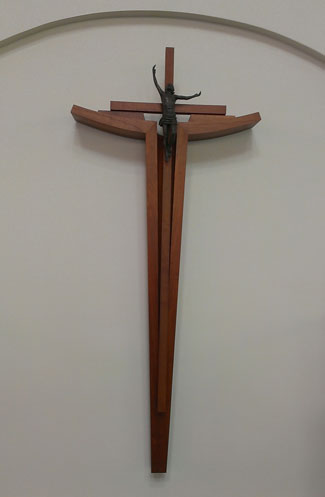
Sisters of St. Joseph
Rochester, New York
In 2003 the Sisters of St. Joseph of Rochester moved into a new motherhouse and decided to commission a new cross to serve as both permanent artwork for the chapel and a processional cross.
The cross was designed by John Dodd, a woodcraft artist. Before beginning his work, Dodd met with the sisters and asked for words to describe the community’s hopes for the cross. The sisters suggested “graceful,” “contemplative,” and “prayerful.” He also studied the space in the chapel so that he could reflect its lines, curves, dimensions, and atmosphere. The corpus for the cross was designed by Sister Catherine Muehlbauer, and it represents a “Rising Christ to his Father in heaven.”
The cross is mounted in the center arch of the chapel wall behind the altar and can be removed when used as a processional cross. It is made of cherry wood, light enough to be easily carried.
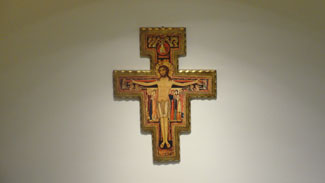
Sisters of St. Francis of Philadelphia
Aston, Pennsylvania
When Saint Francis of Assisi prayed before the crucifix in the little chapel of San Damiano in Italy, he heard a voice saying, “Francis, go repair my house which is falling into ruins.” Francis went about fixing the run-down church, but he eventually understood the message as God’s call to live out a mission for himself and those who followed him. The Sisters of St. Francis of Philadelphia seek to live out that mission and respond with diverse gifts in a spirit of collaboration and mutual service to the needs of others, especially the economically poor, marginal, and oppressed. They use the San Damiano cross as a symbol of the community.
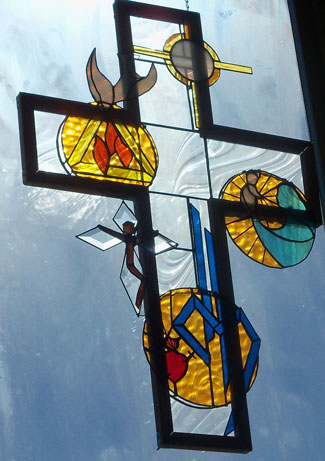
Sisters, Servants of the Immaculate Heart of Mary
Immaculata, Pennsylvannia
In 1845 Redemptorist missionary Father Louis Florent Gillet founded the Sisters, Servants of the Immaculate Heart of Mary. A charism of love, creative hope, and fidelity was passed to Mother Theresa Maxis, the founding mother general, and the first sisters as they sought to educate young people in the Catholic faith.
Today, the sisters continue to live out the charism. The community’s stained-glass cross, handmade by Sister Margaret Faust, symbolizes the congregation’s love for Christ the Redeemer, reliance on Divine Providence, devotion to the Blessed Mother, and love for Jesus in the Blessed Sacrament.
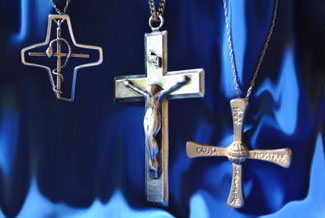
Medical Mission Sisters
Philadelphia, Pennsylvannia
The crosses worn by Medical Mission Sisters reflect the community’s pioneering spirit and internationality.
Their original habit was gray with a royal blue veil in honor of “Our Lady Cause of our Joy” and a traditional silver crucifix. The sisters who wore it would touch it as a reminder of Jesus who was their help, and over time the features of the Christ figure would wear away—a reflection of living the Paschal Mystery.
When the congregation came out of habit after Vatican II and began to wear the local dress of the people they served, the crosses also began to vary with the culture and custom of the areas of their missions. For example, a sister in Africa designed a cross with the world at its center. On its top arm is a medical symbol and on the other three arms are the words “Cause of our Joy” in Latin. Another sister in North America designed a cross that has been adopted as the Sector North America Congregational Cross. She included an inner slender cross with a snake coiled around it, which is a healing symbol from the Book of Numbers. The open cross, which frames the inner one that floats freely within, symbolizes the freely given and joyful service of the sisters.
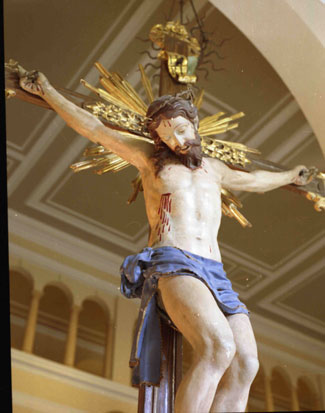
Xaverian Missionaries
Parma, Italy
As a student in Italy, Saint Guido Maria Conforti, founder of the Xaverian Missionaries, had a habit of stopping at a church on the way to school to pray in front of a huge crucifix. During these times, as his love of the crucified Jesus grew, he developed a sense that he was being called to the priesthood. He began to nurture his desire to live his life for the good of others so that others could experience the same joy he did during his encounters with the Crucified Lord.
Today, 730 Xaverian Missionaries serve in 20 countries worldwide, particularly in Asia and Africa.
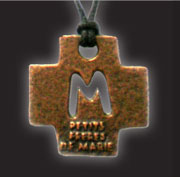
Marist Brothers
Bayonne, New Jersey
A bronze cross is given to each Marist Brother when he becomes a Novice, to wear as a symbol of the community’s common identity around the world. Founded in France, the Marist Brothers were originally called Petit Freres de Marie (Little Brothers of Mary). In the center of the cross is an “M” for "Mary,” patroness of the community. The “M” mimics a young person’s handwriting, reminding the brothers of their mission with youth. On the back are six small nail heads, a reminder that the first brothers had to fabricate nails to sustain the community.
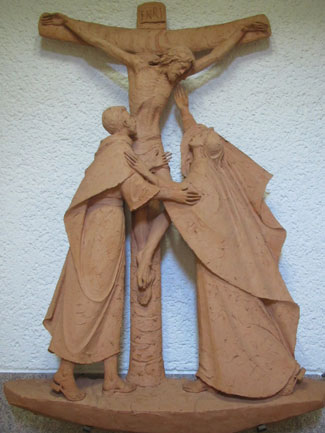
Marianists
Mineola, New York
“Son, behold your Mother. Mother, behold your son.” For Marianists, this Calvary group from the community’s Generalate in Rome captures the essence of Marianist spirituality as sons of Mary and brothers to each other. “Be really faithful to the Lord,” instructed founder Blessed William Joseph Chaminade, “not as a slave through fear, but as a son through love.”
Every afternoon, by longstanding tradition, the members of the Society of Mary, along with students and collaborators, recite the “Three O’Clock Prayer,” recalling the alliance with Mary and participation in her mission of bringing Christ to the world.
Tags
Related
- Literature makes good people better
- Icons: An age-old entrée into the divine
- Religious communities have deep and diverse roots
- Scientific wonder is God’s handiwork
- Respite and renewal brought to you by religious communities
- Lives that lead to God: Biographies and memoirs
- Religious orders aid and advocate for migrants
- Rural religious take to the highways and byways
- Divine design: The holiness of place
- More prayer spaces of religious communities Read More
Most Viewed
- Find your spirituality type quiz
- Questions and answers about religious vocations
- Celibacy quiz: Could I be a nun? Could I be a brother? Could I be a priest?
- Resources for older discerners or those with physical and developmental differences
- About Vocation Network and VISION Guide


